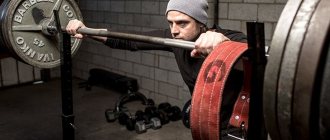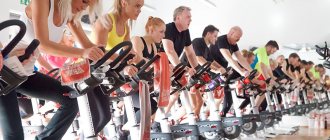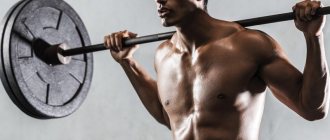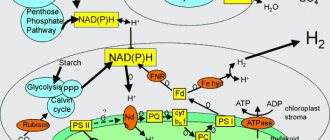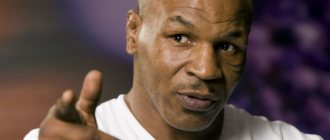Author: Timko Ilya - the ruler of the entire site and fitness trainer | more details >> Rod. 1984 Trained since 1999 Trained since 2007. Author and creator of the site tvoytrener.com. CCM in powerlifting. Champion of Russia and South Russia according to AWPC. Champion of the Krasnodar region according to IPF. 1st category in weightlifting. 2-time winner of the Krasnodar Territory championship in t/a. Author of more than 700 articles on fitness and amateur athletics. Author and co-author of 5 books.
Place in the ranking of authors:
out of competition
(become an author)
Date:
2014-08-29
Views:
28,541
Rating:
5.0
| All articles by the author >> | Medals articles >> |
Articles are loading...
To begin with, I will say a few words about what this method is. Because not everyone is familiar with him. Mike Mentzer (pictured on the left) described this method in his book “Supertraining”. Its essence is that there is no need at all, or rather, it is not necessary to do several approaches to any muscle group.
Physiologists have long proven that when we do a set, only the last repetitions are decisive against the background of extreme fatigue of the working muscles. That is, if we can achieve this extreme fatigue in just one approach, then there is no need for other approaches. I studied human physiology at university for four years, and I would say that this is true. And from a physiological point of view, Mentzer’s method is ideal.
But that is not all. Mentzer decided not to stop there and moved on. Again, based on physiology. It has long been a known fact that the greater the load on the muscles, the more time the muscles need to recover and super-recover. And our body doesn’t care whether we did 5 approaches or just one. The main thing is the final effect. And the final effect here is the degree of muscle fatigue, which, according to Mentzer, can be achieved in one approach.
But I never said where Mentzer went after all)) Based on all of the above, he decided that each muscle can and should be trained once every 7 - 10 days. Why is that? There have been several experiments that have shown that the first negative changes in muscles begin to occur no earlier than 10 days after stopping training. That is, these are only the very first negative changes. AND NOT EARLIER than 10 days later. That's why Mike decided that 7 - 10 days was the optimal period. And the muscles will have time to rest, and degenerative changes will not yet have time to occur. But this, mind you, is provided that you have brought your muscles to maximum fatigue during training.
I think that now you understand the essence of the technique. We take some muscle group and do 2-3 exercises for it. But ONE approach per exercise until complete failure. Then we give these muscles a rest for 7–10 days. That is, during these 7–10 days we train other muscles, with which we do the same.
Childhood
Mike Mentzer was born on Since childhood, the boy was fond of team sports, until he came across the “Kachkovsky” magazine. Photos of bodybuilders with powerful biceps captured children's imaginations. Since then, he “got sick” with iron and determined his life priorities. An understanding father bought sports equipment and strongly supported his son in his endeavors. At the age of 15, the well-built young man had abs of steel and impressive biceps. After school, he was drafted into the Air Force, which did not stop him from training there for 3 hours a day, excluding Sundays.
Premiere performances and new patterns of thinking
Success came at the age of 19 after his debut on “Mr. Pennsylvania”. He inspired an ambitious guy who decided to become the first in weightlifting. In 1971, the athlete entered his candidacy for the Mr. Olympia competition and won 10th place. It was a good result for a newbie, but not for Mike. He decided to radically change his training strategy. His acquaintance with Arthur Jones and the work of Ain Reid helped him in this. The coach suggested a new technique; reading the three-volume book “Atlas Shrugged” changed the picture of the world, added courage and self-confidence. He began to think philosophically, which helped him move away from mental patterns and discover his creative abilities.
Does this technique work?
From a physiological point of view, everything is ideal. And everything should work perfectly. And it really works! But, alas, not everyone has it. Why is this so? But the fact is that in addition to physiology, there is also psychology.
Not all people can force themselves to give their all in one approach!
And this one line reveals why Mentzer’s technique does not work for everyone. To force your muscles to work to the point of complete failure and complete exhaustion, you need enormous moral and volitional efforts. You have to kind of step over yourself. And our psyche is structured in such a way that it is more comfortable for a person (in terms of psyche) to do 3–4 approaches, but not to the point of complete exhaustion, than to “die” in one approach.
Let me remind you, if anyone doesn’t know, that Mike Mentzer himself was a winner of the Mr. Olympia tournament. In addition, he trained many outstanding bodybuilders using this training system. I myself used this method, both on myself and on my students. And this method WORKS! You just need to know, are you ready to step over yourself and do this super approach?
Left without a title
In 1979, Mentzer took part in the annual Mr. Olympia show. He became first among weightlifters and second in the absolute, losing the prize to Frank Zane. Ambition motivated me to repeat the success next year. During these years, the athlete was in better shape. There are no complete anthropometric data, but the surviving figures allow us to judge the dimensions.
- With a height of 173 cm;
- the athlete weighed 103 kg;
- biceps girth was 47 cm.
By this time he had an army of fans and numerous victories. To prevent the guy from having star fever, fate brought a surprise in the person of Arnold Schwarzenegger.
Despite his announcement of retirement, the 6-time champion decided to participate in Olympia, where he took the championship. Mentzer was a fiasco - he had to settle for 5th place. The judge's decision caused controversy among the tournament participants. Since Arnie's anthropometric data were inferior to those of the contenders for prizes, biased assessments gave rise to rumors about the corruption of the competition. Mike believed that his victory had been blatantly stolen from him and did not want to participate in the vanity show anymore. He announced his resignation and switched to coaching .
| Year | Competitions | Place |
| 1976 | Mister Universe | 2 in the category up to 90 kg |
| 1977 | Mister Universe | 2 in the category over 90 kg |
| 1978 | World Amateur Championship | 1 in category Heavyweight |
| 1979 | Pittsburgh Pro | 2 |
| 1979 | Mr. Olympia | 1 in the category over 90.7 kg |
| 1979 | Grand Prix Canada | 2 |
| 1979 | Night of Champions | 3 |
| 1980 | Mr. Olympia | 5 |
Life after sports
The bodybuilder devoted the next 20 years to working with youth, creativity and restoring health. Mike Mentzer's books about sports are read with interest by beginners and masters of strength sports. They are among the top ten best bodybuilding aids.
The athlete’s main achievement is the creation of a new system, which he tested on Dorian Yates, a 6-time Mr. Olympia.
Despite the fact that he began training using it at the age of 20, which is late by bodybuilding standards, the results at the very first tournament confirmed the effectiveness of the system. Previously, Mike tried to implement a similar principle from Coach Johnson into his training, but there was little effect. After analyzing the system errors, he realized that there were no results due to muscle overtraining.
Mentzer training system
High-intensity training (HIT) using the athlete's method has revolutionized the world. Until this time, in the 80s, bodybuilders adhered to the volumetric training of the German school, which was actively promoted by Joe Weider. More than one generation of bodybuilders grew up on it.
The system is based on a three-phase principle:
- slow reproduction of movements;
- strict execution of technique;
- a small number of repetitions.
The author of the new technology believed that only stress load at the limit of strength and work to muscle failure can provoke muscle hypertrophy. The complex consists of 1-2 techniques, which are performed in supersets (for muscle exhaustion) or independently after 2 warm-up sessions. Each involves 1 approach of 6 to 10 takes with heavy weight.
As a result, each muscle group receives maximum load once every 15 days. While some people are training their muscles, others have time to recover and rest. Another important condition is that the period between classes is from 3 to 5 days. This allows you to avoid overloading the body. Mike also insists on a personal approach to work . An athlete must know his strengths and weaknesses and choose the right exercises.
The program involves increasing weight capacity with each workout.
Experiments have shown that in 2 months, beginners manage to increase the power of their quadriceps and move from 80 kg and 6 doubles to 112 kg and 10 repetitions.
Before starting this program, Mike insists on a break of 2-3 weeks to restore biochemical processes and prepare the body for heavy loads.
The nuances of using this technique
The most common technique that will allow you to reach exhaustion in one set is drop sets. The point is that as the approach is completed, the assistants drop the discs from the bar. That is, you perform repetitions without a break, but by lightening the weight of the barbell, you can do the repetitions over and over again. But you need to do this drop set in such a way that you can no longer lift even the minimum weight.
You can also use cheating and partner help. You can read more about all these methods in this article. In general, pervert as you want, but after the approach your muscles should refuse to obey you.
Personally, I use this method widely in basic exercises. Namely in squats with a barbell and in deadlifts. The fact is that we almost never do these exercises to failure. This is understandable, because it is very dangerous. But once every 1 - 2 months I allow myself to perform one approach with 70% - 80% weights from maximum to complete exhaustion. And strength indicators are growing! If, of course, you recover normally after this.
Mike Mentzer's main program
First training day – Monday:
- Torso - arm raises + superset on a bench.
- Back - pullover in the simulator, alternatively - with apparatus + reverse grip deadlift.
Friday workout is dedicated to legs:
- leg extensions;
- platform press;
- working your calves with tiptoe lifts.
Tuesday – working on the deltoids and arms:
- swing projectiles from a standing and bent position;
- superset with barbell lift;
- forced push-ups on parallel bars;
- block press to the belt.
Saturday – legs again:
- squats - better in the simulator;
- working out the legs;
- extension of the limbs.
In his book about super training, Mike Mentzer explains why he considers the method highly effective. In addition to the main group, multi-joint exercises involve other muscles. So, with HIT on the chest, the triceps and shoulder joints work together. For deadlifts, the entire lower body + arms and shoulders.
Pain training or HIT by Mike Mentzer
Inexperienced bodybuilders perceive pain as a sure sign of complete muscle exhaustion and immediately stop performing the approach or exercise. It seems to them that this is a failure and they will not be able to do a single more repetition in the exercise. Well, what if you try to continue the exercise further, ignoring the muscle pain? Few people think of this. Meanwhile, muscle pain indicates the onset of the most productive phase of training.
Let's say you did a set of barbell curls. The last repetition was, as it seemed to you, really the last. A burning, unbearable pain appeared in my biceps. It looks like you really did everything you could...
Not really! This is where your training partner comes to your aid and helps you do 2-3 forced, really last, repetitions.
You will again think that this is it, but no, with the help of your partner you will do 2 more negative repetitions. Those. your partner performs the positive phase of the exercise for you, and you lower the weight yourself, overcoming gravity.
This can be called “identifying hidden reserves.” Remember, you wanted to stop at the last repetition of the set. It turns out that you, without knowing it, systematically gave yourself some slack during training? Well, this is a typical story...
There is no need to be afraid of pain. Along with the pain, your muscles grow from repetition to repetition. This is an indisputable postulate, confirmed by the experience of champions. All professional bodybuilders these days practice “pain” training. Any approach in the usual sense of the word for us – professionals – is something like a warm-up before starting real work, which begins with the last repetition.
Can an amateur train like this? Why not? However, along this path there are many pitfalls that are worth paying attention to:
1. Forced and negative repetitions have to be done while overcoming severe muscle pain, and moreover, in a state of extreme fatigue. All this excludes technically correct execution of the exercise. The athlete tries to overcome some part of the trajectory with a jerk, but this inevitably injures the joints and ligaments. It is necessary to remember that the weights in the “painful” training phase must be moved with extreme caution.
2. The quick results that come with “painful” training make the athlete very happy. And he is ready to use this new method almost endlessly, forgetting about moderation. However, the effectiveness of “painful” training is the result of the addition of two different factors: intensity and individual endurance of the body. If the first factor is entirely in the power of the bodybuilder, then the second depends on the length of training and genetics. A bodybuilder should closely monitor his psychophysiological state. At the first sign of overwork, you should quit the method! Otherwise, you may end up overtraining.
It should be emphasized that pumping up supermass in bodybuilding just comes down to finding a safe path between the pitfalls of pain training. Someone turns out to be more fortunate and for decades successfully maneuvers between ligament tears common to professionals and a landslide drop in mass as a result of overwork. Well, someone’s star sets with the first fatal injury.
Pain training requires enormous internal potential. Amateurs should not tear their hair out in doubt whether they have such potential. This is not about genetic advantages. Everything is much simpler and more complicated at the same time.
Painful training is stress of a global nature. It would seem that the ability to overcome such stress depends entirely on physiology. But no, stress endurance is determined by the psyche!
Experiments on the study of stress have shown that the strongest stresses pass without a trace if a person consciously condemns himself to them in the impulse of moving towards some significant goal. If there is no positive motivation, stress turns into illness.
Pain training is easy for professionals because they are passionate about winning. They are highly motivated.
It is difficult to develop such motivation in yourself if you don’t care about bodybuilding. Pain training and a superficial attitude towards sports are incompatible. So I won’t risk recommending my method to all amateurs. If a bodybuilder takes up pain training out of sheer curiosity, the risk of injury and overtraining is too great. This is exactly the case when the end does not justify the means.
If you do decide to try it, I recommend that you start with mental exercises. Ask yourself: why am I doing bodybuilding? If you answer “I have to do bodybuilding in order to...”, then you need to shake out your internal baggage.
The fact is that bodybuilding cannot serve as a support for some third goal that is not related to bodybuilding. If you are looking to “bulk”, you should WANT to bodybuild. Otherwise, one day when you HAVE to go to the gym, you WILL want to do something else, like stay home and watch TV. It is well known that emotions sooner or later prevail over duty. That is why it is so important for you to put at your service the most powerful human emotion - WANT. Think about it, a person builds rockets and flies to the stars not because he has to, but because he wants to...
About nutrition
Mike argued that building a beautiful body with dense muscles is possible only through nutrition. A scientific approach to the culinary topic allowed us to set out 3 main postulates in “Heavy Duty”:
- consumption of demystified (pure) products;
- creating a balanced diet;
- following a diet with a calorie content of 6 thousand kcal.
In short, nutrition is based on consuming enough nutrients. This means BJU, water, nutrients.
Tragic departure
Steroid use affected my health. Mike suffered from constant pneumonia, and in addition developed pulmonary thrombosis and heart failure. In addition, he underwent surgery on the cervical vertebrae. He was invigorated in every possible way, did not complain to others about his illness, and was going to pompously celebrate his 50th anniversary. Alas, I didn’t have time. He died in the summer of 2001 in Los Angeles. The cause of the tragedy was a heart attack. An autopsy showed a high concentration of morphine in the blood.
Death
Years of hard training and taking various drugs for rapid muscle growth took their toll when Mentzer no longer competed himself, but trained other bodybuilders. He had problems with circulation, lungs and spine. At the same time, he continued to work hard, relieving pain before training by taking morphine. Although all this caused him great discomfort, the man did not plan to completely give up sports.
DY n MM #theShadow #dorianyates #dynutrition #bodybuildinglifestyle #HIT #intensity #training #gym #muscle #growth
Posted by Dorian Yates Sunday, March 18, 2020
Mike Mentzer and Dorian Yates
In 2001, Mentzer was living in an apartment in Los Angeles, where his brother Ray found his lifeless body. After the autopsy, it turned out that the cause of death was a heart attack; a large dose of painkiller was found in the man’s body, which contributed to cardiac arrest.
For Ray, the death of his brother was a great tragedy. He also had health problems, he suffered from kidney disease and was just undergoing treatment. Like Mike, he took morphine. Against the backdrop of great stress, his pain worsened; he took a slightly larger dose of painkiller, which became fatal for him. Ray died 2 days after his brother.
